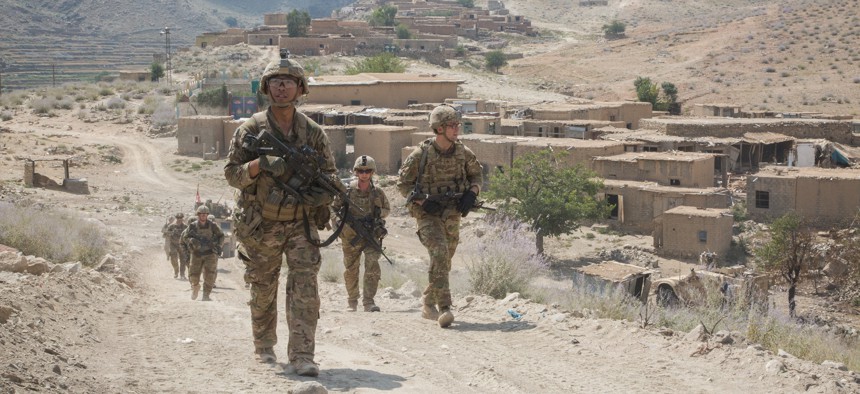
U.S. paratroopers, assigned to 2nd Battalion, 501st Parachute Infantry Regiment, 1st Brigade Combat Team, 82nd Airborne Division, conduct a tactical ground movement through Pekha Valley, Achin District, Nangahar Province, Afghanistan, Sept. 3, 2017. U.S. Army / Cpl. Matthew DeVirgilio
The Missing Debate about Afghanistan
The president’s talk about “wiping” the country “off the face of the earth” highlights the need for a serious talk about U.S. goals and strategy.
Speaking to reporters during the recent visit of Pakistan’s Prime Minister Imran Kahn, President Donald Trump lamented the state of the Afghanistan conflict and boldly asserted an easy win, if only it were fought like a proper war. “We’re like policemen. We’re not fighting a war. If we wanted to fight a war in Afghanistan and win it, I could win that war in a week,” Trump said. “I just don’t want to kill 10 million people.” Continued the U.S. president, “I have plans on Afghanistan that if I wanted to win that war, Afghanistan would be wiped off the face of the earth. It would be gone; it would be over literally in 10 days.”
Putting to the side the morality, legality, and strategic sensibility of Trump’s claims, his comments drew a rare moment of public attention to America’s longest-ever war and the lack of public debate about it. “The world should know that the Trump administration has not forgotten, the American people have not forgotten” Afghanistan, Secretary of State Mike Pompeo said recently, and yet it is far from clear that the war registers for most Americans even as a top-ten issue or concern.
Many do not even realize the United States still has an estimated 14,000 troops still deployed in Afghanistan, 17 years after the initial invasion. Roughly half are training and supporting Afghan security forces, the rest engaged in counterterrorism operations. While U.S. casualties are down dramatically—deaths peaked in 2010 with 498—Americans are still fighting and dying in Afghanistan. On Monday, the Department of Defense announced that two U.S. servicemembers were killed, bringing the number to 15 for 2019, just hours after Secretary Pompeo indicated that the President wanted to reduce troop levels before the 2020 election. (Nearly 45,000 Afghan security and police forces have been killed in the last five years alone.)
Perhaps most glaring in the President’s comments is the inference of a strategic dialogue as to what the United States is still aiming to achieve in Afghanistan. After 17 years, many would be forgiven for wondering: Exactly what are our political and military goals in that country?
Related: How a Forever War Ends
Related: Escalating the US Air War in Afghanistan Isn’t Working
Related: It’s Getting Harder to Track US Progress in Afghanistan
While not a Jeffersonian democracy, Afghanistan has made notable if uneven political and social strides. Yet security is tenuous at best; the Taliban remains active, while the three-year-old Islamic State-Khorasan, or IS-K, is raising renewed concerns about the county’s stability.
Late last year, the Taliban and Afghan government came together at the negotiating table in Doha, Qatar, but the success of these talks remains far from certain. Both sides have intensified their attacks in pursuit of leverage at the talks; civilians are dying in particular in the Taliban’s attacks on government and military facilities.
The United States’ primary goal could be fairly summed up as: stop the Taliban from taking over Afghanistan and prevent them from once again giving safe haven to extremists looking to export terrorism. A secondary goal is providing breathing room for the UN- and NATO-backed government in Kabul to fully stand up and steady itself.
It is certainly debatable whether either of these goals are being achieved. Will current diplomatic initiatives and peace talks really convince supposedly “reconcilable” elements of the Taliban to lay down their arms and join a political process? Can the United States indefinitely sustain its current model of operations: low troop levels, sustained counterterrorism operations by special operations forces and armed drones, and training for Afghan security and police forces? And will that model be sufficient to meet American ends?
An even more pressing question is whether the United States’ continued presence in Afghanistan is palatable to a war-weary American public and political class. Clearly, divisions over Afghanistan’s direction exist even at the highest policy levels in Washington. Recall that former Defense Secretary Jim Mattis resigned last December at least in part because of his disagreement with President Trump’s proposal to withdraw nearly half of the 14,000 troops in Afghanistan (though the president has since backtracked, at least for now).
What seems abundantly clear is that the consequences of a unilateral U.S. troop withdrawal would be dramatic and almost certainly unpalatable to the governments in both Kabul and Washington, D.C. A return of the Taliban would likely undo all of the progress made in Afghan civil society in areas such as education, women’s rights, health care, and democratic reforms.
A precipitous and unilateral U.S. withdrawal would also further erode confidence in America’s commitments to its allies and global partners. Given the recent example of the premature U.S. withdrawal from Iraq in 2011, there is also a distinct possibility that U.S. troops would be forced to return to Afghanistan in the future under even worse circumstances.
The profound sacrifice by U.S. servicemembers in Afghanistan over nearly two decades demands an honest debate about the best way forward. What’s needed is a national strategy that balances still achievable goals and still sustainable means, and thus attracts significant public support. President Trump’s flippant remarks about “wiping” Afghanistan “off the face of the earth” only highlights the absence of serious debate, and an abdication by U.S. political leaders responsible for rallying the country behind our troops.



